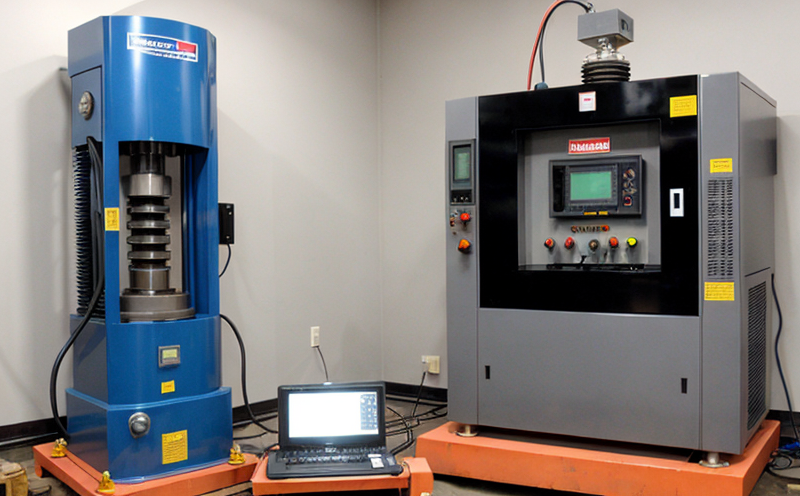DIN 50100 Shock Resistance Test for Metallic Materials
The DIN 50100 shock resistance test is a crucial part of the mechanical testing regime used to evaluate the durability and integrity of metallic materials under dynamic load conditions. This test is particularly important in sectors such as automotive, aerospace, and defense where components are subjected to significant shocks during operation or transport.
The DIN 50100 series is an extensive set of standards developed by the German Institute for Standardization (DIN), which provides guidelines for mechanical testing methods. The shock resistance test specifically addresses the need to simulate real-world conditions that metallic materials will face, ensuring they can withstand sudden impacts without failure.
The test involves subjecting specimens to a series of short-duration, high-impact forces in different directions and magnitudes. This helps engineers understand how well a material or component can resist damage from external shocks. The results are critical for quality assurance processes, as they provide data that informs design modifications and ensures compliance with industry specifications.
The test setup typically includes a shaker table or drop tower, which applies controlled shock loads to the specimen. The equipment used must meet precision requirements specified by DIN 50100 to ensure accurate results. Specimens are carefully prepared to represent actual components, including any surface treatments or coatings that may affect performance.
The test parameters are defined in detail within DIN 50100, specifying the range of shock forces and frequencies to be applied. These parameters are chosen based on expected operational conditions, ensuring the testing accurately reflects real-world scenarios. The acceptance criteria for the test determine whether a specimen passes or fails, typically involving no visible damage after exposure.
Understanding the results from this test is essential for quality managers and compliance officers as it provides insights into material robustness and potential areas of improvement. For R&D engineers, this data can guide iterative design processes to enhance product performance. Procurement teams benefit by ensuring suppliers meet stringent quality standards before integration into larger systems.
By conducting DIN 50100 tests regularly, organizations can maintain a high level of assurance that their components will perform reliably under shock loading conditions. This proactive approach not only enhances customer satisfaction but also reduces the risk of product failure in critical applications.
Why It Matters
The mechanical shock and vibration testing is vital for ensuring the safety, reliability, and longevity of metallic materials used in high-stress environments. Compliance with DIN 50100 standards ensures that products meet international quality benchmarks, which is crucial for global market access.
- Ensures compliance with international standards
- Enhances product reputation among buyers
- Reduces the risk of product failure in critical applications
- Promotes consistency across different manufacturing processes
- Aids in identifying potential weaknesses in materials and designs
The results from these tests are also valuable for regulatory compliance, especially in industries subject to stringent safety regulations. By demonstrating adherence to such standards, manufacturers can build trust with customers and regulators.
Furthermore, the data obtained from DIN 50100 testing is instrumental in ongoing research and development efforts. Engineers can use the insights gained to refine materials and improve product design, leading to more robust and efficient components.
Quality and Reliability Assurance
The quality assurance process for DIN 50100 shock resistance testing involves several key steps to ensure that every test conducted meets the required standards. The first step is selecting appropriate specimens representative of the products being tested. This ensures that the results accurately reflect real-world conditions.
- Selection of specimen types and sizes
- Preparation of specimens according to DIN 50100 specifications
- Application of controlled shock loads using calibrated equipment
- Data collection and analysis following standardized procedures
Once the tests are completed, detailed reports are generated that document all aspects of the testing process. These reports serve as a valuable resource for quality control teams, providing them with comprehensive information about each test's outcome.
The data collected during these tests also plays a critical role in continuous improvement efforts. By analyzing trends over time, organizations can identify areas where improvements are needed and implement changes that enhance product performance.
Finally, the results from DIN 50100 shock resistance testing contribute significantly to maintaining customer satisfaction. When customers know that their products have been rigorously tested according to recognized standards, they gain confidence in the quality of those products.
Customer Impact and Satisfaction
The impact of DIN 50100 shock resistance testing extends beyond internal processes; it directly influences customer satisfaction by ensuring that products perform reliably under all expected conditions. When customers receive products that have been thoroughly tested, they can trust that these items will function as intended without unexpected failures.
- Enhances product reputation among buyers
- Promotes consistency across different manufacturing processes
- Aids in identifying potential weaknesses in materials and designs
- Reduces the risk of product failure in critical applications
- Ensures compliance with international standards
Clients benefit from this testing by receiving products that are not only reliable but also meet or exceed industry expectations. This can lead to increased sales, repeat business, and positive reviews, all contributing to higher customer satisfaction levels.
In industries where product reliability is paramount, such as automotive or aerospace, the value of DIN 50100 shock resistance testing cannot be overstated. It provides peace of mind for both manufacturers and customers, knowing that products have been rigorously tested before reaching end-users.





